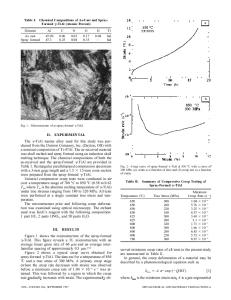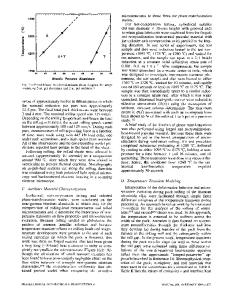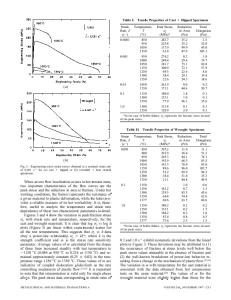Segregation and homogenization of a near-gamma titanium aluminide
- PDF / 4,121,839 Bytes
- 13 Pages / 613 x 788.28 pts Page_size
- 68 Downloads / 330 Views
I.
INTRODUCTION
T H E processing of advanced materials often comprises a series of operations including melting, casting, one or several deformation processes, and intermediate and final heat treatments. Each step can strongly influence the final microstructure and, hence, the final properties. In addition, it is very common that processing costs represent a substantial portion of the final product cost for advanced materials. Thus, there are important technical and economic factors to consider in the development of manufacturing sequences for new alloys. The near-gamma titanium aluminides offer promise as candidate materials for applications requiring high strength and oxidation resistance at high temperatures ( - 8 0 0 ~ a regime presently dominated by nickel- and iron-base superalloys, t~l Although a number of near-gamma alloys have been produced by both conventional ingot- and powder-metallurgy techniques, relatively little effort has been expended in developing and optimizing thermomechanical processes for these materials and in understanding the processing-microstructure relationships that may be required to translate the current laboratory-scale efforts t2,3,41 to full-scale production. An important factor that should be considered in the design of processing methods for ingot-metallurgy neargamma titanium aluminides is the occurrence of
S.L. SEMIATIN, formerly Senior Research Scientist, Metals and Ceramics Department, Battelle Memorial Institute, Columbus, OH, is now Senior Scientist, and P.A. M c Q U A Y is Materials Research Scientist, Metals and Ceramics Division, Materials Directorate, Wright Laboratory, Wright-Patterson Air Force Base, OH 45433-6533. Manuscript submitted April 30, 1991. METALLURGICAL TRANSACTIONS A
microsegregation, tS~ A result of the double-cascading pertitectic reactions that characterize the high-temperature phase equilibria around the equiatomic composition in the titanium-aluminum binary t6,7,81 and associated multicomponent systems, this microsegregation is typically manifested by bands of lamellar, two-phase (alphatwo + gamma) constituent and single-phase gamma grains. During casting, the former component solidifies initially as dendrites and the latter subsequently forms between the dendrite arms. It has been found that this segregation can persist during various working and heattreatment operations in the two-phase alpha + gamma (or alpha-two + gamma) field. Heat treatment of sufficient duration in the single-phase alpha field is required to homogenize such microstructures, t9~ The objectives of the present work were twofold. The first aim was to establish the exact nature of the microsegregation in ingot-metallurgy near-gamma titanium aluminides. If diffusion is sluggish, the phase diagram suggests that (brittle) high aluminum content gamma can be retained in the interdendritic single-phase regions after solidification; by contrast, the lamellar two-phase regions would be expected to have gamma of lower aluminum content. I6,7,81Therefore, the first objective was to deter
Data Loading...











